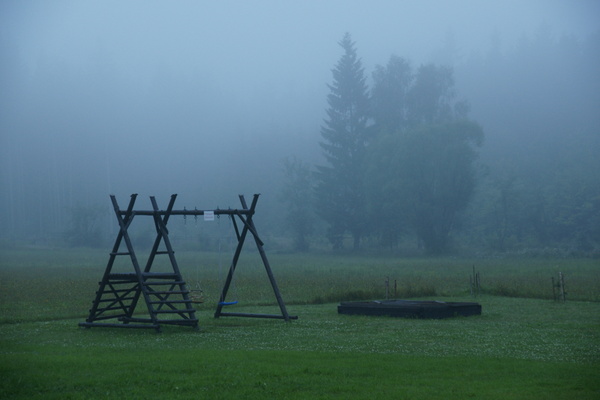Tue, 19 Aug 2008
New Laptop: Is Bigger Better?
I am considering buying a new laptop instead of my old ASUS M6R. The biggest problem is that I don't know whether I want a big or small one (see below). My requirements for a laptop are:
- No preinstalled Windows - I don't want to pay a Microsoft tax.
- No nVidia graphics. I want it to be as much open-specs as possible, so either Intel or ATI (even shared-memory one, as I don't need much 3D power).
- Long battery life (but I don't know what does it mean today).
- Bluetooth, 2+ USB ports, built-in camera.
- Under 20,000 CZK (about 800 Euro).
- At least 2 GB RAM. For my workload RAM is what matters most.
- SD and possibly CF card reader would be nice.
- Three or four mouse buttons would be nice, but apparently these times laptops instead of two scrolling buttons which could be easily configured as middle mouse button, tend to have a fingerprint reader.
- Probably a dual-core CPU around 2 GHz (my Pentium M 1.5 GHz is mostly able to play HD video, so in fact I don't need much more CPU power).
When one wants to go shopping for the above specs, it becomes obvious how badly designed various computer e-shops are, not even speaking about the vendor pages: for example ASUS Czech has its laptop section divided into the following subsections: Business, Digital home, New concept, Personal entertainment centre, Portability, Perfect mobility, and Display size. How TF am I supposed to know whether I want a "New concept" notebook or a "Perfect mobility" one, when my most important feature is "No Windows"? There are only two exceptions: Mironet and Alza. Their e-shops allow to filter laptops according to various criteria, including "No OS". The only problem is with graphics card - the "no nVidia" is impossible to choose - user would need to enable all other graphics cards (not vendors) one-by-one.
Anyway, the filtering gave me the following two laptops: ASUS F3E (15.4", Core2 duo 2.4 GHz, Intel graphics and WiFi, up to 3 hours on battery, not sure how good is its Linux support), and MSI PR210X (12.1", Turion X2 2 GHz, ATI integrated graphics, Atheros WiFi, 4 hours on battery, works with Linux). I am surprised that I am still not sure whether I want a 15.4" laptop or 12.1" one. Having a small laptop would definitely be nice, but strictly speaking, I don't need it: when I want to be ultra-portable, I have my Nokia n810. Any suggestions, my dear lazyweb?
Thu, 14 Aug 2008
Orange Sunglasses and Chromatic Aberation
I bought a new sunglasses for use on my bicycle. Somebody recommended orange colour because of supposedly better levelling between shade and light (which I often need, esp. on the forest roads), so I went for orange ones. I have discovered that when riding a bycicle, I see the edges of shadows coloured asi if my eye had chromatic aberation:
The edges where the sunny part is nearer to me tend to be blueish, while the opposite edges are yellowish. It is only visible when in move. When I stop, the aberation disappears. Can anybody explain this? The "when moving only" part could be explained by focusing to a different part, and seeing the shadows only marginally. Or is it a known optical illusion?
Wed, 13 Aug 2008
Password Manager
Leaving the PalmOS platform, I need a new tool for storing my passwords securely (I have been using GNU Keyring with its JPilot conduit so far). What do you use for your passwords? Is it secure, easy-to-use, synchronizable both with other computers (think using the password data from home and work computers) and with other platforms (Nokia maemo in my case)?
I am thinking about GNOME Revelation, but I am not sure about its synchronization abilities. The other options are Gringotts (which has a maemo port as well), pwsafe (which is said to be compatible with Bruce Schneier's passwordsafe), or gpassman.
Tue, 12 Aug 2008
Alpha 700
My old camera stopped working with any memory card bigger than 512 MB, so I have finally decided to buy a true D-SLR. Having several Minolta-A mount lenses and a Minolta-compatible flash, I have decided to buy a Sony Alpha, which is a successor of Minolta (later Konica-Minolta) cameras.
I had a great dilemma choosing between α350 and α700 (both links point to in-depth reviews at dpreview.com). The first one is a newer "higher entry-level" SLR with 14.2 megapixels, live view on a tilting LCD display, etc. The latter is a semi-pro body about a year older, 12.2 megapixels, bright pentaprism (cf. pentamirror in α350) viewfinder, etc. But no live view.
After reading the above reviews and the article "Which Sony Alpha?", which directly addressed my dilemma, I have decided to go for a slightly more expensive α700 (the difference was not so big because I wanted the SAL 16-105 lens, which is sold in a set with α700, but has to be bought separately for α350).
Want to see the photos? Look at the last page of the above reviews. Some of my own photos are here (not edited, just scaled down; click for the full version):

This one has been taken by my wife.

From a tearoom in Hlinsko, IIRC.

Zelená hora in Žďár nad Sázavou.

Even the photos in a foggy weather are not bad.
So, after several weeks of using α700, I can wholeheartedly recommend it. Maybe it does not have many exceptional functions, but for many of them there are dedicated buttons, which means you can actually use those functions in real life shooting. Nobody who is in a hurry would use functions hidden in some deep menus. Also their dynamic-range optimization really works and is useful, as well as their anti-shake system built in the body (instead of in the lens, like other vendors). So far I have found only one drawback: the exposure bracketing can bracket by at most 0.7 EV steps, which makes shooting frames for HDR[?] photos from hand difficult. The only workaround I have discovered is to use five frames instead of three, which gives you a range of +/-1.4 EV. Another drawback is that my home workstation is too slow to handle 12-Mpix files, so I would probably have to upgrade soon.
Update - Thu, 20 Nov 2008: Fixed in new firmware
The version 4 firmware adds a wider EV range of bracketing (upto +/- 2 EV), so the problem with usability for taking HDR photos from hand is gone. Good. On the other hand, the α900 full-frame body is out now, so my α700 is officially obsolete now :-/
Mon, 11 Aug 2008
What's Wrong With GIMP?
I have recently came across this discussion under the article at Root.CZ. More than half of the discussion is centered around GIMP and its (un)usability.
Every now and then I read those complaints: the GIMP user interface is bad, user-unfriendly, unintuitive, etc. As a casual GIMP user, I do not get it: for me, GIMP is easy to work with. As far as I can remember, when learning to work with it (and having previously used only simple bitmap editors like XPaint), the most mentally difficult feature for me were layers. Once I got used to what layer means and what can I do with it, I found it quite natural and intuitive.
Do you also find the GIMP unintuitive and hard to use? What part exactly you do not like?
Mon, 04 Aug 2008
Won a Lottery
There are things that can be bought for money, and there are things that cannot. The following one is from the later category:
From: Theodore Ts'o
Subject: Maintainer's Lottery: Invitation to the 2008 Kernel Summit
Greetings,
This year, we will be hosting the 2008 kernel summit in Portland,
Oregon, just before the Plumber's Conference.
[...]
This year, we are continuing the MAINTAINERS lottery which we start last
year. The way the lottery works is that we pick 5 people at random from
the MAINTAINERS list and invite them to attend the kernel summit.
[...]
:-) As you may have guessed, you were picked in the lottery, and we hope
that you will be able to join us.
Yay! Now to get the visa paperwork done and to secure the funding :-)